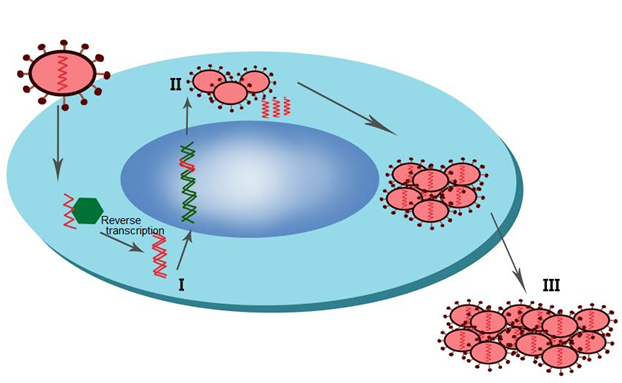Question
Answer: Option D
:
D
Replication of HIV:
1. When the HIV virus enters the human body it attacks macrophages, begins replication, and simultaneously enters T helper cells where it eventually disintegrates the T helper cells after replication.
2. The surface of T helper cells has numerous glycoprotein receptors to which the flexible HIV surface proteins attach.
3. After binding on to the T helper cell's surface, the viral envelope diffuses on its surface and only HIV RNA enters the cell, and undergoes reverse transcription using the host cell's machinery to form HIV DNA.
4. HIV DNA incorporates into the T helper cells' DNA and directs the infected cells to produce viral particles (HIV RNA and viral particles - viral envelope, capsid, enzymes).
5. Copies of viral particles assemble and are then released out of the infected T helper cells.
6. Viruses mature and become capable of infecting other TH cells. This infected TH cell finally disintegrates. After some years, the infected TH cells start dying more quickly than they can be replaced and thus, immunity is severely compromised.
Was this answer helpful ?
:
D
Replication of HIV:
1. When the HIV virus enters the human body it attacks macrophages, begins replication, and simultaneously enters T helper cells where it eventually disintegrates the T helper cells after replication.
2. The surface of T helper cells has numerous glycoprotein receptors to which the flexible HIV surface proteins attach.
3. After binding on to the T helper cell's surface, the viral envelope diffuses on its surface and only HIV RNA enters the cell, and undergoes reverse transcription using the host cell's machinery to form HIV DNA.
4. HIV DNA incorporates into the T helper cells' DNA and directs the infected cells to produce viral particles (HIV RNA and viral particles - viral envelope, capsid, enzymes).
5. Copies of viral particles assemble and are then released out of the infected T helper cells.
6. Viruses mature and become capable of infecting other TH cells. This infected TH cell finally disintegrates. After some years, the infected TH cells start dying more quickly than they can be replaced and thus, immunity is severely compromised.
Was this answer helpful ?
More Questions on This Topic :
Question 3. Anaphylaxis is ....
Question 4. Identify I, II, III in the following image: ....
Question 6. Treatment of snakebite by antivenom is....



















Submit Solution